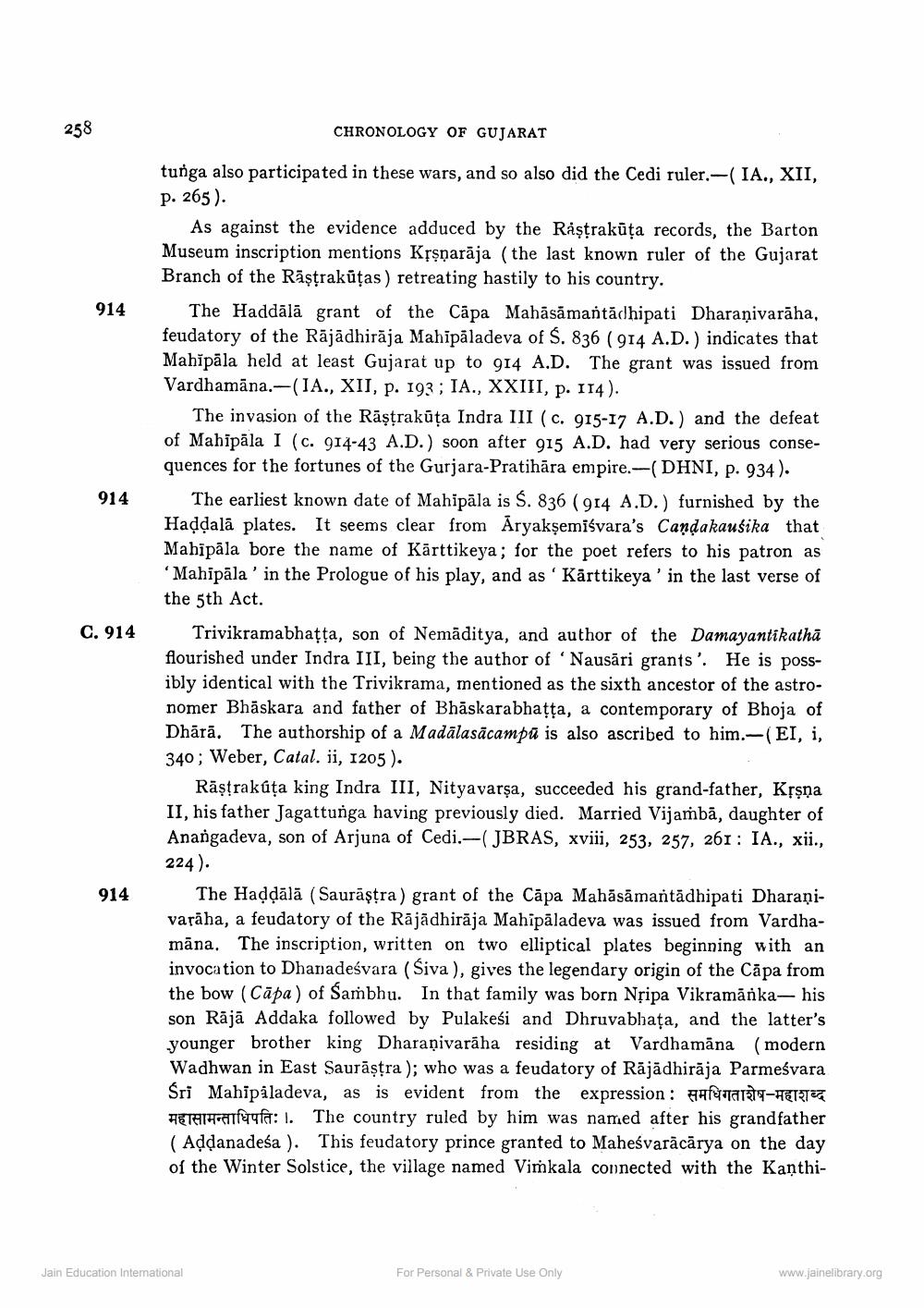________________
258
CHRONOLOGY OF GUJARAT
tunga also participated in these wars, and so also did the Cedi ruler.-(IA., XII, p. 265).
914
914
C. 914
As against the evidence adduced by the Råştrakūța records, the Barton Museum inscription mentions Kșşộarāja (the last known ruler of the Gujarat Branch of the Rāştrakūtas ) retreating hastily to his country.
The Haddālā grant of the Capa Mahāsāmantadhipati Dharanivarāha, feudatory of the Rājādhirāja Mahīpāladeva of $. 836 ( 914 A.D.) indicates that Mahỉpāla held at least Gujarat up to 914 A.D. The grant was issued from Vardhamāna.--(IA., XII, p. 193; IA., XXIII, p. 114).
The invasion of the Rāştrakūța Indra III (c. 915-17 A.D.) and the defeat of Mahīpāla I (c. 914-43 A.D.) soon after 915 A.D. had very serious consequences for the fortunes of the Gurjara-Pratihāra empire.-(DHNI, P. 934).
The earliest known date of Mahipāla is $. 836 ( 914 A.D.) furnished by the Haddalā plates. It seems clear from Aryakşemiśvara's Candakauśika that Mahīpāla bore the name of Kārttikeya; for the poet refers to his patron as
Mahipāla ' in the Prologue of his play, and as 'Kārttikeya ' in the last verse of the 5th Act.
Trivikramabhațța, son of Nemāditya, and author of the Damayantikatha flourished under Indra III, being the author of Nausāri grants'. He is possibly identical with the Trivikrama, mentioned as the sixth ancestor of the astronomer Bhāskara and father of Bhāskarabhațța, a contemporary of Bhoja of Dhārā. The authorship of a Madālasācampū is also ascribed to him.-(EI, i, 340 ; Weber, Catal. ii, 1205 ).
Rāştrakúța king Indra III, Nityavarşa, succeeded his grand-father, Krşņa II, his father Jagattunga having previously died. Married Vijaṁbā, daughter of Anangadeva, son of Arjuna of Cedi.-( JBRAS, xviii, 253, 257, 261: IA., xii., 224)
The Haddālā (Saurāṣtra) grant of the Capa Mahāsāmantādhipati Dharanivarāha, a feudatory of the Rājādhirāja Mahipāladeva was issued from Vardhamāna. The inscription, written on two elliptical plates beginning with an invocation to Dhanadeśvara (Siva ), gives the legendary origin of the Căpa from the bow (Cāpa) of Sambhu. In that family was born Nřipa Vikramāka-his son Rājā Addaka followed by Pulakesi and Dhruvabhața, and the latter's younger brother king Dharaộivarāha residing at Vardhamāna (modern Wadhwan in East Saurāşțra ); who was a feudatory of Rājädhirāja Parmeśvara Sri Mahipaladeva, as is evident from the expression: afetante-HETTS HETATHafayfa: I. The country ruled by him was named after his grandfather (Addanadeśa ). This feudatory prince granted to Maheśvarācārya on the day of the Winter Solstice, the village named Viņkala connected with the Kanthi
914
Jain Education International
For Personal & Private Use Only
www.jainelibrary.org




